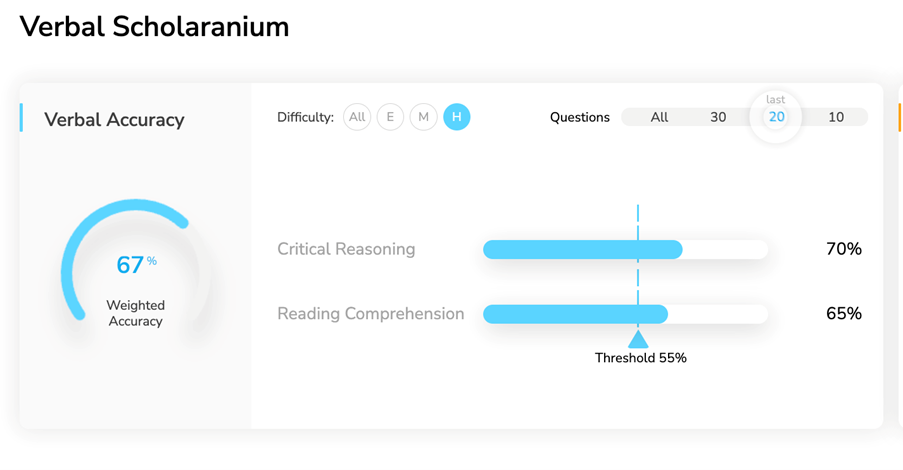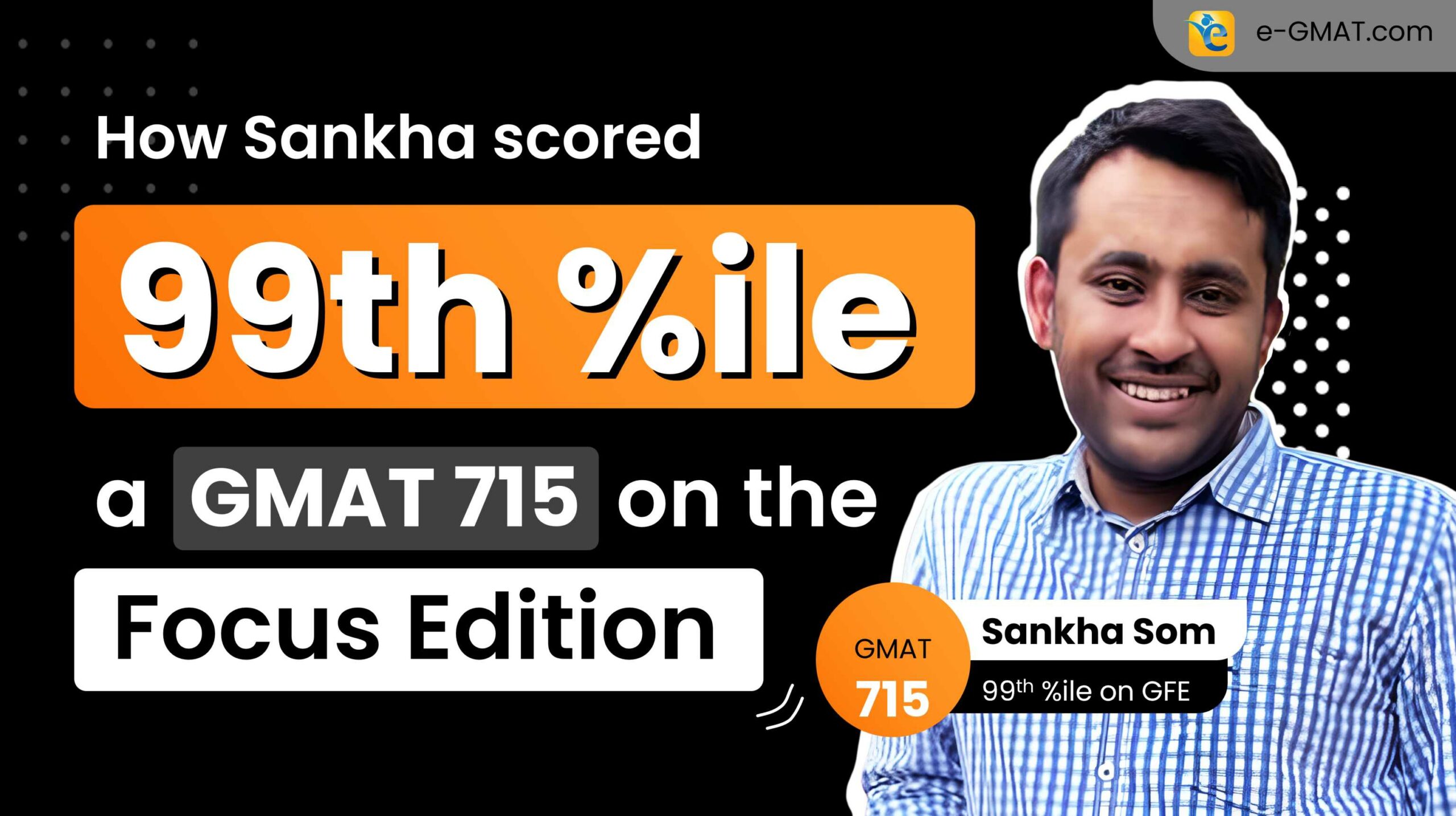Most GMAT aspirants would consider a 70-point improvement a significant achievement that takes months of dedicated preparation. When that improvement happens in just 40 days, it becomes a story worth telling.
For Darshit, an IIT Kanpur graduate with a unique combination of engineering precision and poetic intuition, this transformation wasn’t just about the numbers – it was about fundamentally reshaping his approach to the GMAT.
“I think the most important factor in GMAT is not about what concepts you know, but how you think,”
His journey from 625 to 695 challenges conventional wisdom about GMAT preparation timelines. As an engineer working in startups by day and curating a popular Rumi poetry page by night, Darshit brought a distinctive perspective to his GMAT preparation. Yet, this same analytical mind that helped him excel at IIT initially proved to be a double-edged sword in his GMAT journey.
His first attempt at the GMAT yielded a score of 625 – respectable, but far from what he knew he was capable of achieving. Despite strong fundamental knowledge, particularly in Quant, something wasn’t clicking. “When I started, I thought Quant would be the easiest part for me,” Darshit admits. “But as I started giving mocks and as I gave my first attempt, I came to know that it’s not as simple as it looks.”

“If I was practicing in an untimed manner, I used to get almost all the questions correct,” he explains, highlighting a crucial insight that would shape his preparation strategy. “But when I used to practice in a timed manner, I used to take a little bit more time in some of the questions, and because of that, my whole section used to suffer.”
This gap between knowledge and execution became the catalyst for a transformation that would see him improve his score by 70 points to 695 (Q88, V85, D80) in just 40 days. . Through a combination of structured mentorship, analytical preparation, and a fundamental shift in thinking patterns, Darshit would discover that the key to GMAT success lies not in what you know, but in how you think. As we delve deeper into Darshit’s journey, we’ll uncover how he transformed his GMAT preparation from a test of knowledge into a strategic pursuit of excellence.
The Unexpected Challenge: When Engineering Meets GMAT Quant
For an IIT Kanpur graduate, struggling with GMAT Quant might seem counterintuitive. Yet this paradox became the defining challenge of Darshit’s GMAT journey. “When I started, I thought Quant would be the easiest part for me,” he recalls, a sentiment shared by many engineers approaching the GMAT. “But as I started giving mocks and as I gave my first attempt, I came to know that it’s not as simple as it looks.”
The disconnect was puzzling at first. In untimed practice, Darshit could solve almost any question correctly. His engineering background had given him a solid foundation in mathematical concepts. However, when faced with the pressures of timed practice or actual tests, a different story emerged. Questions that should have taken two minutes stretched to three or four, creating a domino effect that impacted his entire section performance. This revelation led to a critical insight: GMAT Quant success isn’t just about knowing how to solve problems—it’s about knowing how to solve them efficiently and systematically.
Darshit’s Challenges in Quants:
THE QUANT PARADOX
- Strong Conceptual Understanding:
- Could solve problems correctly in untimed settings
- Comprehensive knowledge of mathematical concepts
- Confident in problem-solving ability
- Execution Challenges:
- Inconsistent timing across question types
- Variable performance under pressure
- Impact on overall section management
The pattern became clear through his practice on the e-GMAT platform. Out of the typical 21 questions in a Quant section, about 16-17 should be straightforward executions for someone at his level. These were questions where, as Darshit puts it, “you don’t have to think a lot. It will just happen as soon as you see the question.” The remaining 4-5 questions would naturally require more time and deeper thinking. The key was managing this distribution effectively.
As you can see in the image below, while Darshit solved 18 questions in reasonable time, excessive time spent on 3 questions derailed everything.

This realization marked a turning point in Darshit’s preparation. The challenge wasn’t about learning new concepts or mastering complex mathematical principles—it was about transforming his approach to problem-solving. He needed to develop a systematic process that would allow him to:
- Instantly recognize question types
- Execute standard problems efficiently
- Manage time effectively across the entire section
- Maintain consistency under pressure
“I know the concepts,” Darshit acknowledges, “but I don’t know exactly the steps in which I have to apply it.” This insight would become the foundation of his strategic transformation. For GMAT success, especially in Quant, it wasn’t enough to know what to do—he needed to internalize how to do it systematically and efficiently.

This systematic approach to timing and question management ultimately led to a 7-point improvement in Quant (Q81 to Q88), enabling Darshit to perform at the level his engineering background suggested he could.”
The Strategic Shift: When an Engineer Reads Like a Poet
The most fascinating aspect of Darshit’s GMAT transformation came from an unexpected source: his dual identity as both an engineer and a poetry enthusiast. While his analytical mind had served him well in many areas, his breakthrough in Verbal came when he learned to leverage his artistic side – particularly in his approach to Reading Comprehension.
As the curator of a popular Rumi poetry Instagram page, Darshit was no stranger to complex texts. Yet his initial approach to GMAT passages wasn’t yielding the results he wanted. The breakthrough came when he fundamentally shifted his reading perspective.
THE READING REVELATION
- Initial Approach:
- Reading for personal understanding
- Processing information through analytical lens
- Focusing on details over purpose
- Transformative Shift:
- Reading from author’s perspective
- Understanding passage purpose
- Focusing on authorial intent
“I was not thinking from the author’s perspective,” Darshit explains. “I used to read it to understand what the passage is trying to tell me and not what the author wants to tell me.” This distinction might seem subtle, but it proved transformative. When reading poetry, understanding the poet’s intention is crucial – and Darshit realized this same principle could revolutionize his approach to GMAT passages.
The impact of this shift extended beyond just Reading Comprehension. “This is the same for both CR and RC,” he notes. His new approach of conscious reading and intention-focused analysis created a ripple effect across the entire Verbal section, increasing his accuracy on hard questions.
Darshit’s Verbal Transformation to V85:
In the image below, we can see how this helped him achieve a 65-70% accuracy for hard questions in CR and RC:

VERBAL STRATEGY EVOLUTION
- Reading Comprehension:
- From: Passive information absorption
- To: Active author intention analysis
- Critical Reasoning:
- Enhanced conclusion identification
- Stronger argument structure analysis
- More precise assumption recognition
This transformation in approach wasn’t just about changing how he read – it was about changing how he thought about reading. By bringing together the precision of his engineering mindset with the interpretative skills honed through poetry appreciation, Darshit created a unique and effective approach to GMAT Verbal.
His transformed approach to reading yielded impressive results: Darshit achieved a V85, demonstrating how effectively he combined his analytical mindset with his poetic sensibility. His accuracy on hard RC and CR questions improved to 65-70%, proving the effectiveness of his author-centric reading strategy. This revolutionary shift in verbal approach, combined with his systematic improvements in Quant, laid the foundation for his remarkable 70-point improvement
As we’ll explore in the next section, these strategic changes were supported and enhanced by a structured mentorship system that helped maintain focus and accountability throughout his preparation journey.
The Power of Structured Support
After his initial GMAT attempt, Darshit faced a critical challenge: he had exhausted his practice tests and was grappling with disappointment. His transformation from this low point to achieving a 695 highlights the crucial role that structured support played in his success.
From Doubt to Direction
“I remember that first mock after my initial attempt – I didn’t score very well, and I was very disappointed,” Darshit recalls. “At that point, I was thinking that okay, I should just quit giving GMAT itself.” This moment of crisis became a turning point, thanks to immediate mentor intervention.
Impact of LMP on Darshit’s Success:
MENTORSHIP IMPACT
- Critical Intervention:
- Immediate response to setback
- Data-driven performance analysis
- Clear action plan development
- Psychological Support:
- Confidence rebuilding
- Perspective adjustment
- Motivation maintenance
The mentor’s approach was both practical and motivational. “I had a chat with you, and you showed me that okay, you made a lot of silly mistakes. It’s fine – you can give another mock the next day.” This simple but powerful combination of acknowledgment and action planning proved crucial. When Darshit took that next mock test, he achieved a significantly better score, reinforcing his confidence and commitment.
The Structure Effect
Perhaps the most transformative aspect of the mentorship was the introduction of clear structure and accountability. “You told me to do specific things – X task on this day, Y task on this day,” Darshit explains. “That really helped because I started feeling accountable.”
This structure proved particularly valuable given Darshit’s 40-day timeline. Every day needed to count, and the mentorship system ensured that it did. The combination of platform analytics and personal guidance created a feedback loop that continuously optimized his preparation.
The Confidence Multiplier
One of the less obvious but crucial benefits of structured support was its impact on confidence. Having someone who could provide perspective during challenging moments and validate progress during successful ones created a stable foundation for improvement.
“If someone is telling me that okay, this is possible, then I should listen to them and not just to my brain,” Darshit reflects. This external perspective proved invaluable in maintaining focus and motivation throughout his preparation journey.
The effectiveness of this support structure was ultimately validated by Darshit’s test day performance. Despite facing unexpected challenges, particularly in the DI section where he spent over eight minutes on a single question, he maintained his composure and executed his strategies effectively, achieving his impressive 695 score.
This structured support system, combining mentorship guidance with platform analytics, provided the framework that enabled Darshit’s improvement. The structured support system’s effectiveness was evident in the numbers: From nearly quitting after a disappointing mock to achieving consistent mock scores above 650, ultimately leading to a 695 on test day. As we’ll explore in our final section, these elements came together on test day to produce results that exceeded expectations.
From Preparation to Performance: Test Day and Beyond
For Darshit, test day became the ultimate validation of his transformed approach to the GMAT. With Quant as his first section, followed by DI and Verbal, he faced both expected challenges and unexpected obstacles that would test his newfound strategies.
Test Day Execution
Darshit’s Quant section exemplified his strategic transformation. “In Quant, I was stuck in two questions,” he recalls, “but towards the end, I changed them from incorrect to correct.” This ability to maintain composure and make strategic adjustments under pressure reflected his evolved approach to the test.
The DI section presented an unexpected challenge that tested his resilience. “I got stuck in one of the questions and spent upwards of eight minutes,” Darshit admits. Despite this setback, which impacted his timing for the remaining questions, he maintained enough composure to secure a solid D80 score.
The Transformation Journey
Looking back at his 40-day transformation, Darshit identified a crucial insight that transcended specific strategies or techniques. “One thing that I learned from GMAT was not about GMAT but about myself – how I think,” he reflects. “Because of that thinking pattern, I was scoring certain scores.”
This self-awareness became the foundation of his success. Rather than fighting against his natural thinking patterns, Darshit learned to adapt them to the GMAT’s requirements. “It’s not a lot about what concepts you know,” he emphasizes, “but it’s a lot about how you think actually.”
Advice for Future Test-Takers
Drawing from his experience of achieving a 70-point improvement in 40 days, Darshit offers three key pieces of advice for future GMAT aspirants:
Darshit’s Takeaways:

SUCCESS BLUEPRINT
- Mindset Matters: Success on the GMAT requires transforming your thinking patterns rather than just accumulating knowledge, as the test evaluates how you process information rather than how much you know.
- Structure Creates Success: A systematic approach with regular feedback and accountability transforms scattered preparation efforts into consistent improvement, making every practice session and mock test count toward your goal.
- Trust the Process: Initial setbacks and disappointing scores are part of the journey, but maintaining faith in proven strategies and staying consistent with your approach will lead to breakthrough improvements.
Perhaps most importantly, Darshit’s journey demonstrates that significant GMAT improvement is possible with the right combination of self-awareness, strategic approach, and structured support. Darshit’s final score of 695 (Q88, V85, D80) represented not just a 70-point improvement in 40 days, but a complete transformation in approach. His balanced sectional scores demonstrated how effectively he had internalized and executed his new strategies across all areas of the test.
Key Takeaway:
“The GMAT tests how you think, not just what you know.”
For those embarking on their own GMAT journey, Darshit’s story offers both inspiration and a practical roadmap. His experience shows that with the right mindset, support system, and strategic approach, remarkable improvements are possible – even within a compressed timeline.
Are you planning to pursue MBA at top business schools? Let us help you conquer the first step of the process i.e., taking the GMAT. Take a free mock test to understand your baseline score and start your GMAT prep with our free trial. We are the most reviewed online GMAT Prep company with 2000+ five star reviews on GMATClub.















